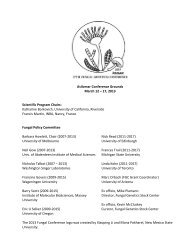Asperfest 4 Program - Fungal Genetics Stock Center
Asperfest 4 Program - Fungal Genetics Stock Center
Asperfest 4 Program - Fungal Genetics Stock Center
Create successful ePaper yourself
Turn your PDF publications into a flip-book with our unique Google optimized e-Paper software.
59. CoA-Transferase from Aspergillus nidulans is required to forward the CoA-moiety from propionyl-CoA to acetate.<br />
Christian Fleck, Matthias Brock. Leibniz Institute for Natural Product Research and Infection Biology e.V. – Hans-Knöll-Institute<br />
(HKI) Contact: christian.fleck@hki-jena.de<br />
Metabolism of amino acids and propionate leads to the toxic intermediate propionyl-CoA. Efficient removal via the methylcitrate<br />
cycle is guaranteed by a functional methylcitrate synthase. Deletion of the coding region of this enzyme leads to the inability to grow<br />
on propionate or ethanol/propionate but not acetate/propionate. This led to the assumption that the level of propionyl-CoA may<br />
become reduced by direct transfer of the CoA-moiety to acetate. Therefore, we purified a CoA-transferase from Aspergillus nidulans<br />
and characterised the enzyme biochemically. The CoA-transferase was specific for the CoA-esters succinyl-CoA, propionyl-CoA,<br />
and acetyl-CoA as CoA-donors and the corresponding acids as acceptors. No other donors or acceptors suited as substrates. To<br />
elucidate the role of the enzyme under in vivo conditions the corresponding gene was deleted. The deletion mutant only showed mild<br />
phenotypes when tested for growth and development on propionate containing media. Therefore, a double mutant with a methylcitrate<br />
synthase deletion strain was created by sexual crossing. In contrast to the methylcitrate synthase deletion strain, the double mutant<br />
was neither able to grow on ethanol/propionate nor on acetate/propionate media. Thus, CoA-transferase is essential for removal of<br />
toxic propionyl-CoA in the presence of acetate as a CoA-acceptor.<br />
60. Gene Silencing by RNA Interference in the Koji Mold Aspergillus oryzae. Osamu Yamada, Ryoko Ikeda, Yuka Ohkita, Risa<br />
Hayashi, Kazutoshi Sakamoto, and Osamu Akita. National Research Institute of Brewing, 3-7-1 Kagamiyama, Higashi-Hiroshima<br />
739-0046, Japan<br />
Aspergillus oryzae is an important filamentous fungus in the Japanese fermentation industry, used in the manufacture of such products<br />
as sake, soy sauce, and miso, as well as in commercial enzyme production. We found the orthologous genes required for RNA<br />
interference (RNAi) in the A. oryzae genome database, and constructed a set of tools for gene silencing using RNAi. This system<br />
utilizes compatible restriction enzyme sites so that only a single target gene fragment is required to create the hairpin RNA cassette.<br />
For ease of handling, we also separated the construction of the hairpin RNA cassette for the target gene from its subsequent<br />
introduction into the expression vector. Using the brlA gene as a target for RNAi, we detected decreased mRNA levels and a delayed<br />
conidiation phenotype in the transformants. Furthermore, even though A. oryzae possesses three copies of the Taka- amylase gene,<br />
a single copy of a Taka-amylase RNAi construct was sufficient to downregulate the mRNA levels and decrease the enzymatic activity<br />
to 10% of control levels. Gene silencing by RNAi should provide a powerful genetic tool for post-genomic studies of the industrially<br />
important fungus A. oryzae.<br />
1 1 1<br />
61. Easy ways to identify veA1 mutation in Aspergillus nidulans. Kap-Hoon Han , Hyoun-Young Kim , Jong Hwa Kim , Hee-Seo<br />
2 2 3 1 2<br />
Kim , Keon-Sang Chae and Dong-Min Han . Dept. of Pharmaceutical Engineering, Woosuk Univ, Wanju, 565-701, Div. of<br />
3<br />
Biological Science, Chonbuk Nat'l Univ, Jeonju, 561-756, Dept. of Life Science, Wonkwang Univ, Iksan, 570-749, Korea.<br />
The veA gene in Aspergillus nidulans plays an important role in light response and the balance of sexual and asexual sporulation. So,<br />
the presence of the veA1 mutation gave us difficulty to study sexual development as well as photobiological research. Because of the<br />
veA1 mutation was caused by a single nucleotide substitution, nucleotide sequencing of the region was the only way for the<br />
verification. Here, we present a few simple ways to identify the veA allele easier than the genome sequencing. First, incubation of<br />
the A. nidulans strains on the medium containing oxalic acid provides clear colony distinguishment between the veA+ and veA1 strain.<br />
Secondly, PCR mediated verification allowed us to distinguish more clearly. The PCR products could only be obtained in the wild<br />
type veA allele using double mismatched primers. Finally, restriction enzyme digestion followed by the PCR amplification of the veA<br />
allele resulted in the clearest result. Since the veA1 mutation eliminated a restriction enzyme site, only the PCR product containing<br />
veA+ allele is subjected to be digested by the enzyme. These methods provided fast and cost-saving ways for identifying the veA<br />
allele.<br />
4th International Aspergillus Meeting 24 Poster Abstracts











